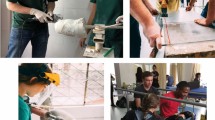Abstract
In this paper we designed a STEM outreach program with a modular tissue engineering education tool (we refer to as “modular cyclic-stretch device”) to engage high school students in STEM hands-on activities. Using simple machines such as gears and rotating cams, students were able to build a custom device to apply cyclic stretch to biomaterials. With the help of this hands-on activity, our outreach program helped students grasp tendon tissue biomechanics and understand the importance of applying biomechanical force to regenerate tendon tissue in a laboratory setting. The two-day outreach program comprised: 1. pre- and post-tests; 2. lectures; 3. laboratory sessions, including the microscopic examination of stained tissue sections and a hands-on group activity employing the modular cyclic-stretch device; and 4. homework. Assessment results suggest that our program supports improved student awareness and interest in tissue engineering as a future profession. The program elevated students’ confidence in their ability to apply engineering principles to tasks such as building a modular cyclic-stretch device and measuring the mechanical properties of biological tissues. Building an educational bioreactor improved students’ understanding of the dynamic nature of the human body and the importance of tissue engineering as an emerging discipline towards replacing or regenerating damaged organs. We propose that our modular device has great outreach potential to introduce tissue engineering concepts to high school and potentially college freshmen engineering students.




Similar content being viewed by others
References
Garceau LR, Ebben WP, Knudson DV. Teaching practices of the undergraduate introductory biomechanics faculty: a North American survey. Sports Biomech. 2012;11:542–58.
Hsieh C, Smith JD, Bohne M, Knudson D. Factors related to students’ learning of biomechanics concepts. J Coll Sci Teach. 2012;41:82–9.
Wang T, Chen P, Zheng M, Wang A, Lloyd D, Leys T, Zheng Q, Zheng MH. In vitro loading models for tendon mechanobiology. J Orthop Res. 2018;36:566–75.
Giuliodori MJ, Lujan HL, Briggs WS, Palani G, DiCarlo SE. Hooke’s law: applications of a recurring principle. Adv Physiol Educ. 2009;33:293–6.
Dyment NA, Barrett JG, Awad HA, Bautista CA, Banes AJ, Butler DL. A brief history of tendon and ligament bioreactors: Impact and future prospects. J Orthop Res. 2020;38:2318–30.
Banik BL, Brown JL. 3D-printed bioreactor enhances potential for tendon tissue engineering. Regener Eng Transl Med. 2020;6(4):419–28.
Svihla V, Petrosino AJ, Diller KR. Learning to design: authenticity, negotiation, and innovation. Int J Eng Educ. 2012;28:782.
Marshall JA, Berland LK. Developing a vision of pre-college engineering education. J Pre-Coll Eng Educ Res. 2012;2(2):5.
Ahluwalia A, Carmelo De Maria J, Madete AD, Lantada PN, Makobore AR, Di Pietro L, Mridha M, Munoz-Guijosa JM, Chacón Tanarro E. Biomedical engineering project based learning: Euro-African design school focused on medical devices. Int J Eng Educ. 2018;34:1709–22.
Birol G, Liu S, David Smith H, Hirsch P. Educational modules in tissue engineering based on the “how people learn” framework. Biosci Educ. 2006;7:1–13.
Harris TR, Brophy SP. Challenge-based instruction in biomedical engineering: a scalable method to increase the efficiency and effectiveness of teaching and learning in biomedical engineering. Med Eng Phys. 2005;27:617–24.
Knudson D, Wallace B. Student perceptions of low-tech active learning and mastery of introductory biomechanics concepts. Sports Biomechanics; 2019
Klein SS. Using a study of skin to teach stress and strain in high school physics, anatomy and physiology, and engineering. In: Proceedings of the 9th international conference on engineering education; 2006.
Freeman S, Eddy SL, McDonough M, Smith MK, Okoroafor N, Jordt H, Wenderoth MP. Active learning increases student performance in science, engineering, and mathematics. Proc Natl Acad Sci USA. 2014;111:8410–5.
Kier MW, Blanchard MR, Osborne JW, Albert JL. The development of the STEM career interest survey (STEM-CIS). Res Sci Educ. 2014;44:461–81.
Unlu ZK, Dököe İ, Ünlü V. Adaptation of the science, technology, engineering, and mathematics career interest survey (STEM-CIS) into Turkish. Eurasian J Educ Res. 2016;16(63):21–36. https://doi.org/10.14689/ejer.2016.63.2.
Ilhan T. Yilmaz F., Kilicer K., Senocak E. The professional and social development of prison staff.” In. Erasmus Program of European Commission: Tokat; 2018
Kraska-Miller M. Nonparametric statistics for social and behavioral sciences. Boca Raton: CRC Press; 2013.
Wright GA. Engineering attitudes: an investigation of the effect of literature on student attitudes toward engineering. Int J Technol Des Educ. 2018;28(3):653–65. https://doi.org/10.1007/s10798-017-9417-0.
Ito TA, McPherson E. Factors influencing high school students’ interest in pSTEM. Front Psychol. 2018;9:1535.
Jung E, Kim JYE. Women in engineering: almost no gap at university but a long way to go for sustaining careers. Sustainability. 2020;12:8299.
Pearson W, Miller JD. Pathways to an engineering career. Peabody J Educ. 2012;87:46–61.
Amelink CT, Creamer EG. Gender differences in elements of the undergraduate experience that influence satisfaction with the engineering major and the intent to pursue engineering as a career. J Eng Educ. 2010;99:81–92.
Reynolds B, Mehalik MM, Lovell MR, Schunn CD. Increasing student awareness of and interest in engineering as a career option through design-based learning. Int J Eng Educ. 2009;25:788.
Acknowledgments
We sincerely thank Professor Isa Gokce for providing his laboratory space for our program and for his support in the certificate ceremony. We appreciate Brennan Cornell’s assistance in machining the cyclic stretch device parts. We also thank our enthusiastic undergraduate students Mukerrem Sima Uncu, Zeynep Binbas, Mirfet Haddat, Hanife Saha and Ismail Furkan Turan for volunteering for the program.
Author information
Authors and Affiliations
Corresponding author
Additional information
Publisher's Note
Springer Nature remains neutral with regard to jurisdictional claims in published maps and institutional affiliations.
Supplementary Information
Below is the link to the electronic supplementary material.
Rights and permissions
About this article
Cite this article
Ozdemir, T., Senocak, E., Gerber, G. et al. The Pull of Tissue Engineering: A STEM Outreach Program with a Modular Cyclic Stretch Device to Engage High School Students. Biomed Eng Education 2, 31–39 (2022). https://doi.org/10.1007/s43683-021-00053-0
Received:
Accepted:
Published:
Issue Date:
DOI: https://doi.org/10.1007/s43683-021-00053-0




